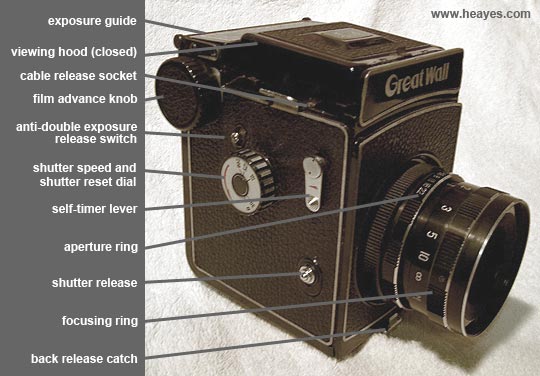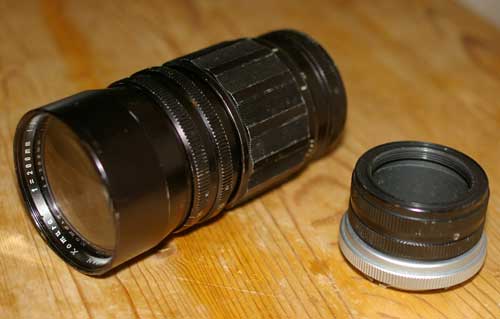the great wall DF-3
The Great Wall DF-3, or "Chang Cheng",
is a Chinese-made medium format SLR camera that
takes twelve pictures at 6cm square , or sixteen
pictures at 6 by 4.5cm on 120 roll film. It can
apparently also shoot 35mm and the defunct 828 format
if you have all the necessary spools and masks that
were originally supplied with the camera.

There are several other models of the Great Wall,
from the DF-1 to the DF-4, and maybe to DF-5 or
even 6, although these would be very rare. This
PDF file
(2MB), kindly provided by Peter,
has more information and pictures of the DF-3 and
DF-4. My second-hand Great Wall was very kindly
sent to me by a friend traveling through China,
but they also turn up from time to time on eBay.
The Great Wall is apparently a copy of the Pilot
Super of the 1930s made by Kamera Werkstatten AG,
which later became VEB Pentacon. It comes with a
standard 90mm lens which gives very sharp and evenly
exposed results. The picture quality is certainly
on a par with the Kiev 88CM.
Here's a large scan and a smaller version of a shot I took with the Great Wall using the standard lens, showing the lovely soft frame edges and wonderful 'bokeh':
The Great Wall has a 39mm screw-type lens
mount that leads one to think that it might be compatible
with some Leica lenses. More on that topic below.
The shutter has speeds of 1/30, 1/60, 1/125, 1/200
and a bulb setting. It has a socket for a mechanical
shutter release, a built-in self-timer, and a double-exposure
prevention mechanism that can be overridden using
a release switch. On the top of the camera
there is an exposure table for 100ASA written in
Chinese. The later DF-4 apparently also has a flash
sync socket.
This is an SLR camera, meaning that a single lens
is used for both viewing and shooting. While focusing,
a mirror directs the image up into the view finder,
and when the shutter is tripped, the mirror flips out
of the way to allow the image to reach the film. After
exposure, the mirror has to be swung back into viewing
position by turning the shutter speed knob in the direction
of the red arrow until it clicks. This can only be done
after you have advanced the film or pressed the double
exposure prevention knob. This also cocks the shutter.
On mine, advancing the film doesn't always release the
double-exposure prevention mechanism, so I often have
to press the release knob.
One common complaint with these cameras is that
the screws tend to come loose because they're not
fixed in place with lacquer. Mine is missing a couple
of screws that hold the film back hinge in place,
but with careful handling I'm still able to open
and close the film back properly.
Sadly I don't have any of the masks and spools
that would let me shoot 6x4.5 and other film formats,
but here's a photo of them from a sale on eBay.

Alternative Lenses
At first I thought that removable lens meant that
other lenses were made for the Great Wall. But it
appears from other information on the web that the
camera's instruction manual says that the lens is
removable so that you can use it on an enlarger.
How handy!
And according to discussions on photo.net, the
Great Wall 39mm mount is not a true M39 mount. A
real M39 mount has only a single diameter, while
the Great Wall DF/M39 mount has a smaller 30 mm
buffer ring immediately behind the 39mm ring, designed
to block the backward movement of lenses so that
they don't impede the shutter mechanism.
But the fact that the Great Wall lens comes off
leads many users to speculate about what it would
be like if you could use a different lens
on the camera.
The old Leica lens mount was also 39mm, but that
doesn't necessarily mean that you can use Leica
lenses on the camera. The first problem is an obstruction
just behind the lens mount that prevents many of
these lenses from being fully screwed in. Secondly,
because of the different flange to film distance,
these lenses can only be used for close-ups within
the range of about 10-20 cm.
Another Great Wall owner I contacted online, Kai
Blanke, has this to say about using Leica and other
lenses: "It should be ok from the circle of
light, given that the flange-film distance is about
2.5 the one of LTM cameras and the negative is not
2.5 times broader. I am not aware that other lenses
are available for this camera, but you should be
able to use some shorter LTM Visoflex lenses (or
enlarger lenses) with extension tubes, but this
might cause vignetting and you will most probably
not have infinity focusing. I always wanted to try
a M39 bellows on it with a long lens in a short
barrel, but usually these bellows cost more than
the camera if they are available."
Kai also mentions that you can use many 39mm screw
mount extension tubes with the Great Wall. You can
also mount many 39mm enlarger lenses on the Great
Wall, but in this case you have no mechanism for
focusing unless you use a bellows.
An alternative approach for those determined to
use different focal lengths is to take advantage
of the Great Wall's convenient 52mm filter mount
to fit a front-mounted conversion lens intended
for video camera. Here's another PDF from Great
Wall owner Peter that discusses these issues.
I've recently bought a wide-angle converter made by Japanese company Digital King that screws on to the standard lens. The converter is actually in two parts. Unscrewing the front component turns it into a macro converter. So with this one converter I have effectively three lenses instead of one. Now, this converter is designed for 35mm and digital SLRs, not MF lenses, and as a result vignettes and softens slightly at the frame edges. For me, this is an added bonus, because I love the antique lens look. Here's a sample with the wide converter.

Some people report being able to successfully mount
Russian M42 mount telephoto lenses with a 42-39
adapter ring. And there is a tantalizing mention
that another Chinese camera called, possibly, the
Shenlong 120, includes an adapter so that they can
be mounted on the Chang Cheng. However, others have
expressed doubts about this.
One lens I've actually tried is an old 200mm telephoto lens made by Komura, aka Sankyo Kohki:

The back end of the lens unscrews as shown above to reveal a 39mm thread that's a perfect match for the Great Wall. I can focus at infinity, and it makes a pretty powerful telephoto. But...a protrusion just behind the lens mount inside the camera means that the top 1/8 of the frame is cut off, like this:

I guess it would be fine if I cropped the shots I take with the lens to a rectangular format. By the way, I don't think the later models of 200mm the Komura lens unscrew like this one, so be careful if you go looking for one.
See my Flickr pages for more Great Wall shots, among other things.
|